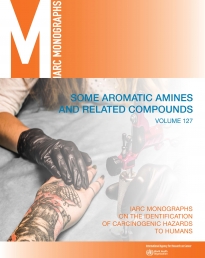
978-92-832-0167-0
978-92-832-0194-6
View The Lancet Oncology summary as HTML or PDF
French version of The Lancet Oncology summary (hosted by Centre Léon Bérard)
Read Q&A
View infographic
This volume of the IARC Monographs provides evaluations of the carcinogenicity of six chemicals: ortho-anisidine and ortho-anisidine hydrochloride, ortho-nitroanisole, aniline and aniline hydrochloride, and cupferron.
ortho-Anisidine, and its salt, ortho-anisidine hydrochloride, are mainly used as chemical intermediates in the synthesis of azo pigments and dyes for consumer products, textiles, paper, and cardboard.
ortho-Nitroanisole is used primarily as a precursor for the manufacture of ortho-anisidine.
Aniline, the parent compound of aniline hydrochloride, is a High Production Volume chemical used in the synthesis of isocyanates, dyes and pigments, and rubber-processing chemicals, and in the production of pharmaceuticals, herbicides, fungicides, and of many consumer goods, including textiles, leather, and colourants, including tattoo ink. Tobacco smoke is a main source of exposure to aniline in the general population.
Cupferron is a reagent used to separate metals such as copper, iron, tin, vanadium, and thorium from other metals.
For all agents, data were sparse regarding exposure levels, but indicated that exposures are higher in occupational situations than in the general population.
An IARC Monographs Working Group reviewed evidence from cancer studies in humans, cancer bioassays in experimental animals, and mechanistic studies to assess the carcinogenic hazard to humans of exposure to these agents and concluded that:
Annex 1. Supplementary material for Section 1, Exposure characterization
These supplementary web-only tables were produced in draft form by the Working Group and were subsequently fact-checked and edited. Please report any errors to imo@iarc.fr.
Table S1.9 Review of exposure assessment quality in cohort studies on exposure to aniline
Table S1.10 Review of exposure assessment quality in case–control studies on exposure to aniline
Annex 2. Supplementary material for Section 2, Cancer in humans
This supplementary web-only table was produced in draft form by the Working Group and was subsequently fact-checked and edited. Please report any errors to imo@iarc.fr.